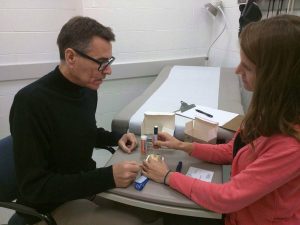Standardized Patient Program
The University of North Carolina School of Medicine’s Standardized Patient (SP) Program serves students across all four years of medical school in addition to students from a number of other health professional schools on campus. The SP program is administered through the Office of Medical Student Education, which is responsible for student assessment; course design; curriculum evaluation and development; program evaluation; and special programs for the recruitment, preparation, and retention of minority and disadvantaged students.
Since the late 1980’s, standardized patients have been an integral part of the school’s educational program. Students encounter SPs as both a learning resource and an assessment tool in the areas of interviewing, physical examination skills, counseling, and taking a history. In addition, the SP program participates in research projects and events aimed at Graduate and Continuing Medical Education (GME and CME).
What is a Standardized Patient?
 An SP is sometimes referred to as a ‘simulated patient’ or a ‘patient actor’ who plays the role of someone visiting a health professional. An SP portrays what is called a ‘case’, or a character. The character is a certain age and has a unique background, life circumstances, and health issues.
An SP is sometimes referred to as a ‘simulated patient’ or a ‘patient actor’ who plays the role of someone visiting a health professional. An SP portrays what is called a ‘case’, or a character. The character is a certain age and has a unique background, life circumstances, and health issues.
The purpose of using SPs is to give our students the opportunity to practice the communication, diagnostic, and examination skills that they need before beginning their clinical rotations and to assess them once they’ve begun working regularly with patients.
SPs are used to both teach and evaluate students’ skills. In some situations students conduct an interview or take a history, much like a doctor would on an initial visit. In other situations, students may perform a physical examination. No physical exams are invasive, but some may require wearing a hospital gown for a heart, lung, or abdominal exam. Usually these encounters are done on a one-to-one basis and videotaped to allow students to self-review their work or faculty to assess student performance.
SET Center staff work closely with SPs to prepare for each session.
For more information about becoming a Standardized Patient, please go to “Potential SPs” Page.
How Are Standardized Patients Used in Teaching?
UNC students work with SPs for two purposes: to learn and practice professional behaviors and clinical skills, and to demonstrate their competence in these same areas.
SPs allow students to practice conducting interviews with patients, counseling patients and developing plans for treatment, and performing clinical examination skills with people who are trained to portray scenarios derived from real clinical situations and challenges. Cases or scenarios are designed to provide an opportunity to develop and refine important skills and to demonstrate competence in those same skills and professional behaviors.
How Standardized Patients are used to assess performance
The most common types of evaluation used by health professional schools to observe and assess students’ clinical skills at key points in their education are the Objective Structured Clinical Exam (OSCE).
- The Objective Structured Clinical Examination (OSCE) allows faculty, SPs, and/or other health professionals to observe and evaluate how well students perform specific clinical skills and behaviors. The exam usually consists of several stations where SPs present a variety of patient complaints. Students rotate through these timed stations. At each station, a student is asked to perform a specific, measurable task, such as taking a patient history or performing a focused physical exam (e.g., heart exam, knee exam, eye exam). SPs and/or faculty graders complete checklists for each observed skill or station.